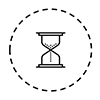In the UK, the Ten Minute Rule allows a backbench member of parliament—one that is neither part of the government nor the opposition—to make their case for a new bill in a speech lasting up to ten minutes. After the ten minutes have passed, another MP may speak for a further ten minutes to oppose the bill.
When a Ten Minute Rule motion passes, it’s added to the list of bills to be debated. It’s a practical and productive way to review issues that can affect legislation.
What would the Ten Minute Rule look like if you applied it to the way you manage your work? Let’s have a look at the Ten Minute Rule of productivity.

Stop procrastinating with the Ten Minute Rule
Metaphorically, procrastination can be seen as the result of a battle between your present self and your future self.
Scientifically, procrastination is the result of a battle between your limbic system—an older part of the brain that’s among many other functions involved in the fight or flight reaction—and your prefrontal cortex—a newer part of the brain where planning complex behaviours and making decisions happen.
Because the limbic system is much stronger, it very often wins the battle, leading to procrastination. We give our brain what feels good now and don’t do what would make us feel better later.
The Ten Minute Rule of productivity is about “tricking” your limbic system by talking yourself into getting started. Instead of focusing on the outcome, it’s about focusing on the output. Avoid overplanning and overthinking. Don’t say you’ll read a chapter of that book; say you’ll read for ten minutes. Don’t say you’ll run a 5K; say you’ll run for ten minutes. Don’t say you’ll build a new feature; say you’ll code for ten minutes.
Why does it work? Because there’s a good chance that once you get started, you’ll keep going for longer than ten minutes. When you don’t want to do something, you often build it up in your mind to be worse than it really is. But once you get started, you get to realistically appraise how long and hard the task is going to be. This process removes most of the anxiety.
Just tell yourself: “I’ll do this thing for ten minutes. Once I get to the ten-minute mark, I’ll decide whether I want to keep going.” Most of the time, you will decide to keep going long past the initial ten minutes.
The idea is to make the task as easy as possible to start. The commitment is so low, it can’t hurt to give it a try. It works even better if you give yourself a reward. “I’ll do this thing for ten minutes. Once I get to the ten-minute mark, I’ll decide whether I want to keep going. Whatever I decide, I get to have this specific reward once I don’t feel like working on this task anymore.”

Why the Ten Minute Rule works
The Ten Minute Rule is about mastering the art of showing up. It’s not about quick wins, it’s about the ripple effect of getting started. There are three main reasons why it’s so effective.
- It’s harder to start than to keep going. Putting yourself in motion when you’re procrastinating is the hardest step. Once you’ve started working on something, it’s easier to get in the flow and forget that you only committed to focus on the task for ten minutes.
- It focuses on the output and not the outcome. Reaching a goal can feel daunting. Working for ten minutes feels easier. Committing to ten minutes of work removes the pressure of “being successful” by shifting the measure of performance to something simple and controllable.
- It helps build new habits. Developing a new routine is hard. And we often make it harder by having lofty goals we can’t stick to. The Ten Minute rule is easy and repeatable, which will help you form new habits.
I personally like to use the Ten Minute Rule of productivity because it allows me to have some sort of tangible output. When I don’t feel like writing, I tell myself I’ll write for ten minutes. When I don’t feel like exercising, I tell myself I’ll go for a ten minute run.
But others have advocated for variations with different time commitments, such as James Clear’s 2-minute rule or Andrea Bonior’s 5-minute rule. The truth is that doesn’t really matter what length you feel more comfortable with, and you should definitely experiment—the principles stay the same.
Commit to a short amount of time, get started, and see if you want to keep on going past the initial few minutes. And if you do decide to stop, a few minutes are better than nothing anyway.
